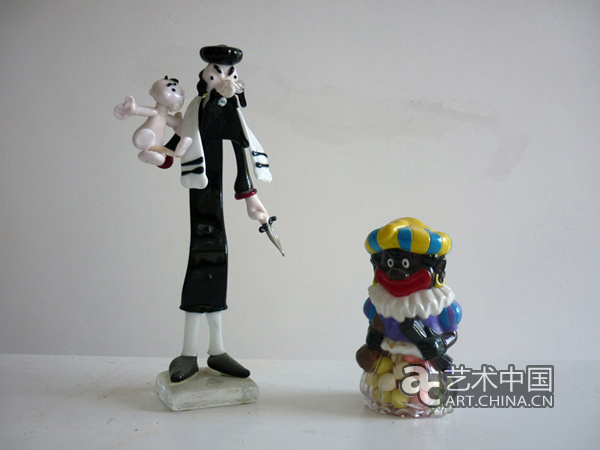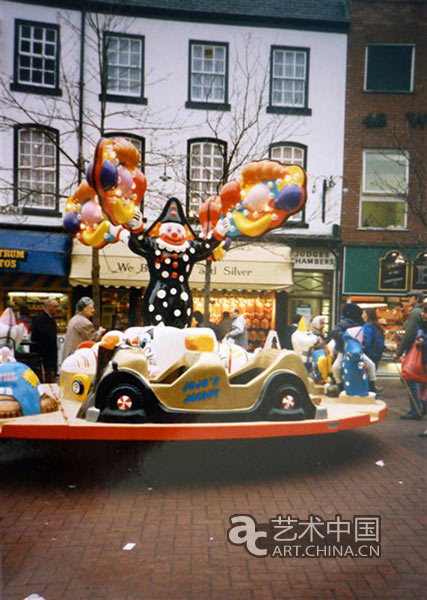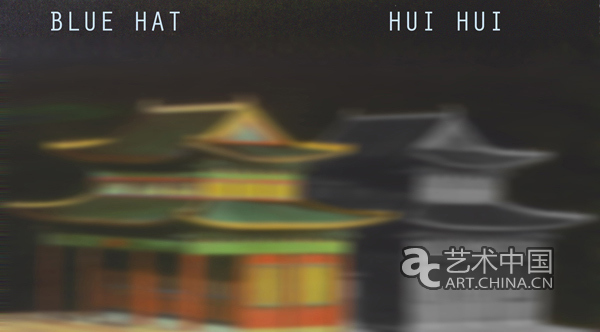
Glass Jew Toy
玻璃猶太人玩偶
Made of Venetian glass, 30 cm long, a figure of a jew holding a knife and a baby. Bought in Venice.
A sweet holder figurine with a minstrel face, 11cm long, bought in Amsterdam, part of a paraphernalia attached to the celebrations of St. Nicholas, where young people depicting 'Zwarte Pieten' (Black Petes) traditionally paint their faces black.
猶太人手持一把小刀和一個(gè)嬰兒,威尼斯玻璃製成,30cm長(zhǎng),購(gòu)于威尼斯。
一座拿著糖果的吟遊詩(shī)人小雕像,11cm長(zhǎng),購(gòu)于阿姆斯特丹,雕像周身佩戴著用於聖尼古拉斯慶典的一些用具。阿姆斯特丹的年輕人將其稱(chēng)為“黑彼得”(Zwarte Pieten),並且有將他們的臉畫(huà)成黑色的傳統(tǒng)。

Clown in Leicester , colour print,10x12cm
小丑,彩色印刷,10x12釐米

Blue Hat, Hui Hui (Kaifeng Synagogue), lambda print, 2010, 90x50cm
藍(lán)帽,回回(開(kāi)封猶太宮殿),照片列印,2010,90x50釐米
Archaelogical evidence suggests that Jews were in China as early as the 8th Century, having arrived from Persia along the Silk Road. In 1163 the Emperor ordered the Jews to live in Kaifeng, where they built the first Chinese synagogue. Marco Polo recorded that Kublai Khan celebrated the festivals of the Muslims, Christians and Jews, indicating that there were a significant number of Jews in China in the 13th Century.
A Ming Emperor conferred on the Jews seven surnames - Ai, Lao, Jin, Li, Shi, Zhang and Zhao. To this day Chinese Jews will only have one of these seven names. Christian missionaries also recorded meetings with Chinese Jews. At least one synagogue was constructed, and the community was active for about eight centuries. Currently, the Vatican holds letters from Jesuits in the 18th Century describing the daily life and religious practices of Jews in Kaifeng, and drawings of their synagogue.
( from internet)
考古證明猶太人早在西元8世紀(jì)就已經(jīng)出現(xiàn)在中國(guó),他們是從波斯沿著絲綢之路來(lái)到中國(guó)的。在1163年,宋帝同意猶太人“留遺汴梁(今開(kāi)封)”,他們?cè)谀茄Y建立了第一個(gè)中國(guó)猶太教堂。據(jù)馬可波羅記載,大汗忽必烈與穆斯林、基督教徒和猶太人一同慶祝過(guò)他們各自的節(jié)日。這暗示了在13世紀(jì)的中國(guó),猶太人已經(jīng)不在少數(shù)。
明朝皇帝賜給猶太人七個(gè)漢姓,分別是艾、高、金、李、石、張、趙。直至今日,中國(guó)的猶太人仍然沿用著七個(gè)漢姓中的一個(gè)。至少有一座猶太教堂建立並且保持了長(zhǎng)達(dá)八個(gè)世紀(jì)的活力。現(xiàn)在教廷扔保存著18世紀(jì)耶穌會(huì)信徒的信件,它們描繪了當(dāng)時(shí)開(kāi)封猶太人的日常生活和宗教活動(dòng),並且畫(huà)出了他們的教堂。(來(lái)自網(wǎng)路資源)